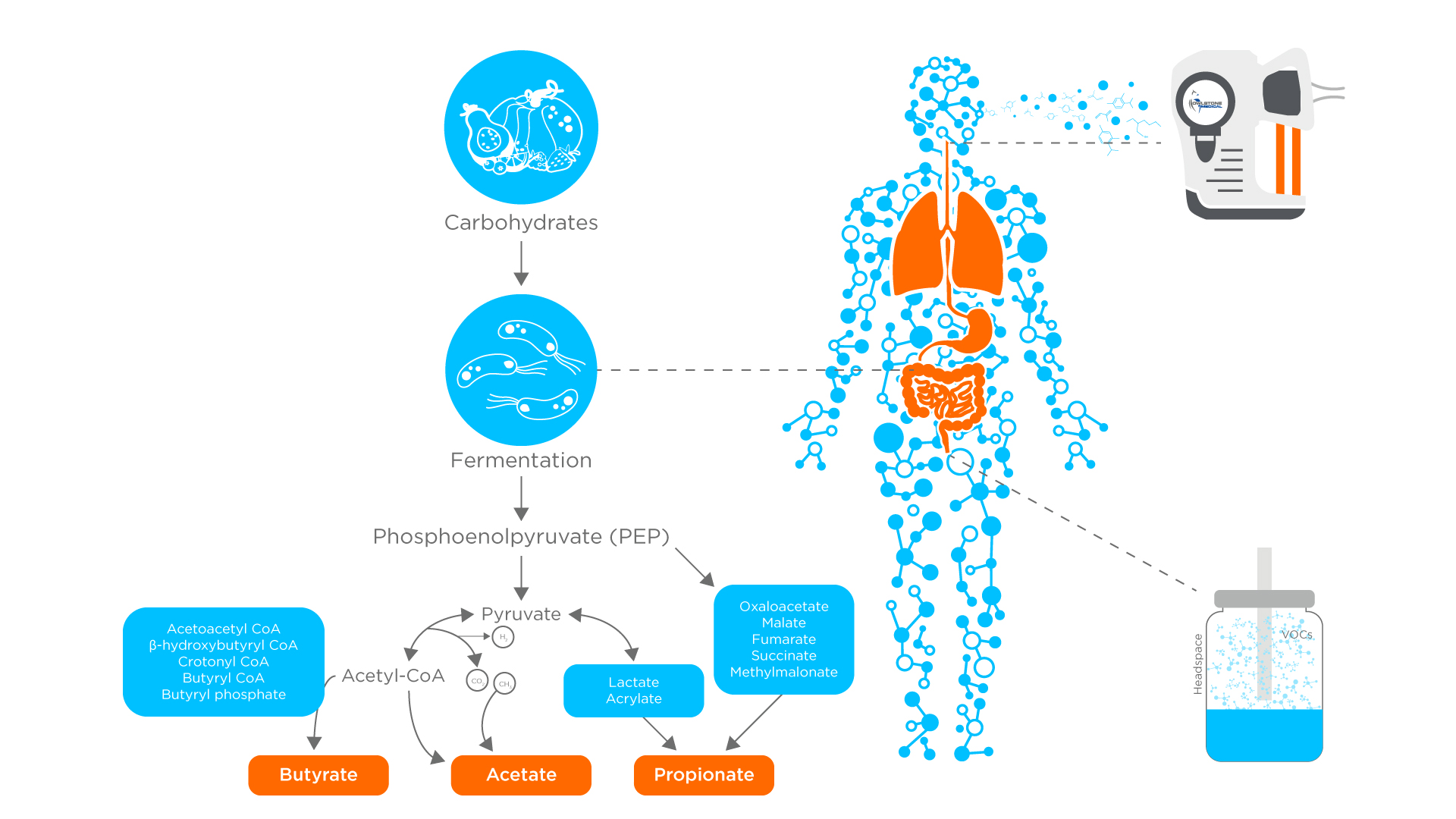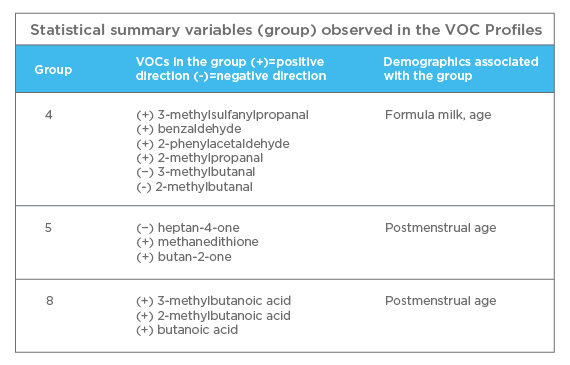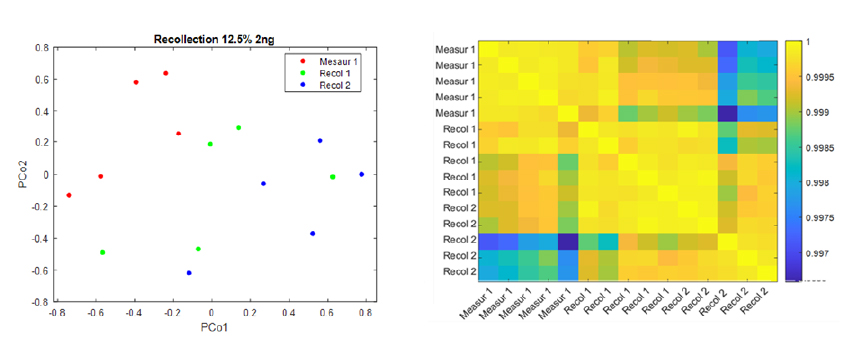Understanding Gut Health Through Breath and Fecal Headspace VOC Analysis
Published on: 17 Feb 2023
When it’s up in the air, trust what your gut is telling you – understanding gut health and associated diseases through breath and fecal headspace VOC analysis.
In our first blog in this series, we discussed how the gut microbiome is complex and vital to maintaining our health and wellness. Many factors can impact the composition of the gut microbiome, and the loss of balance has been known to associate both directly and indirectly with various diseases, including but not limited to irritable bowel syndrome (IBS), inflammatory bowel disease (IBD) and colorectal cancer. These disease diagnoses often require at least one invasive tool like endoscopy and/or colonoscopy, which can be expensive and unpleasant for the patient.

In the last decade, with the advancement of omics data analysis, volatile organic compounds (VOCs) have received more interest as a novel, efficient and non-invasive method for disease diagnosis. VOCs can be emitted from biological samples such as breath and feces. The implication of cellular metabolic states and disease specific patterns make VOCs desirable as potential biomarkers. The sources of VOCs measured from biological samples could be either endogenous or exogenous.
Discover more on VOC Biomarkers
How are VOCs Connected Between Food, Gut Microbes and Disease?
Certain food ingredients like dietary fibers, which cannot be processed by humans, are fermented by microbes in the intestines, resulting in the production of VOCs, including short chain fatty acids (SCFAs) such as acetate, butyrate and propionate, as well as alcohols including ethanol and propanol. The abundance changes of VOCs could indicate potential changes in the gut microbes activity and composition.
Studies in disease areas directly (IBS) or indirectly (colorectal cancer) associated with the gut microbiome have used breath VOC analysis, concluding that VOCs can distinguish between disease and control groups.
A study from Smolinska et al. [1] demonstrated the connection between volatile metabolites in exhaled breath and intestinal microbiota with the same subjects for the first time. Through sample collection and analysis in active and inactive Crohn’s disease (CD) subjects, acetate and propionate were significantly correlated with Bifidobacteria and several other microbes in the Firmicutes phylum in both disease states. The microbial strains and the relative abundances of produced SCFAs both decreased in active disease states. Other findings from the study included significant correlations between inflammation VOC biomarkers like pentane and octane, and Bacteroides fragilis and Ruminococcus gnavus in active disease state subjects. While this doesn’t imply the specific VOCs were produced by these bacteria, their level of abundancy could share a common cause.
A study conducted by Probert et al. [2] showed that fecal VOCs were altered with necrotizing enterocolitis (NEC), a serious gastrointestinal problem that mostly affects premature babies. Fecal samples were collected from 32 premature babies pre-diagnosed and subsequently developed NEC, and 70 controls without NEC, for headspace analysis. VOCs found were clustered into nine different demographic group factors, three were associated with NEC and indicated the possibility of disease up to 3-4 days prior to established clinical diagnosis. Bifidobacteria-produced butyrate, 2-methyl butyrate and 3-methyl butyrate were clustered into the postmenstrual age group, one of the NEC-associated group factors, suggesting an interaction between the maturation of the gut and bacteria colonization. The occurrence of the three VOCs might also reflect the protective effect of abundant bifidobacterial in the controls. Other VOCs not present in NEC-associated groups but significant include aldehydes: propanal, pentanal and hexanal, which may be early indicators of enterocolitis.

Breath vs fecal VOC analysis, is one better than the other?
VOC analysis using either breath or fecal samples is ideal for understanding gut health due to their non-invasive collection method. VOCs (SCFAs, alcohols) found on both breath and fecal samples give flexibility to choose either method to study gut health. depending on your research interests and needs. Several advantages for breath analysis include;
- The standardization of breath sample collection for volatile compounds (volatile compounds can evaporate quickly from liquid/solid samples like feces, yielding variability),
- Breath VOCs reflecting real-time metabolic activity as the compounds pass straight into the blood stream, and the breath, from their generation in the gut, versus from hours-days ago as with feces,
- The ability to repeat sampling within a short time frame (see our EVOC probes®).
These advantages allow flexibility in designing longitudinal studies, especially ones that monitor metabolic changes within hours. The simplicity of breath sample collection also makes it favorable for at-home use development.
While breath offers a number of advantages over fecal sampling, it needs to be acknowledged that, like blood VOCs, breath VOCs will originate from all around the body and not just the gut. Fecal VOCs can also be assessed via headspace analysis. This offers the chance to first identify VOCs known to be produced in the gut, then to target those VOCs in breath sampling and compare levels of them in breath and fecal samples to ensure that studying the VOCs in the breath gives a good representation of gut behaviour.
However, the main challenge to date for performing headspace fecal VOC analysis, is the lack of a standardized research protocol reliable for comparison between studies. Our latest results on fecal headspace , are an important step for demonstrating low technical variability. Using recollected fecal samples, we show no separation within the two recollected samples in PCA plots. Although we see separated clusters between the original and the two recollected samples in PCA, a correlation analysis showed the original and the two recollected samples are highly correlated, above 0.997.

Figure 2: In house fecal headspace sample recollection evaluation shows separate clustering in PCA plot (left) but a high correlation (right) between original and recollected measurements.
If you are interested in using breath as a tool to help understand the gut microbiome better for your research, our Breath Biopsy® OMNI® provides the most advanced solution for standardized breath VOC analysis. The ReCIVA® Breath Sampler and CASPER® Portable Air Supply ensures reduced background noise in breath sample collection, allowing high comparability between different individuals, over different time-courses and sampling locations. We also offer headspace VOC analysis of fecal samples.
Our clients also gain access to our Breath Biopsy VOC Atlas – a comprehensive exhaled breath VOCs catalog capable of facilitating future biomarker discovery as well as providing novel insights into the relationship between gut microbiome-associated diseases and breath VOCs. Currently, gut microbiome-associated VOCs already added to the ATLAS include several short-chain fatty acids (SCFAs) like acetate, butyrate, and propionate, as well as sulfur-containing compounds and aromatic amino acid breakdown products.
References
- Smolinska, A., et al., Volatile metabolites in breath strongly correlate with gut microbiome in CD patients. Anal Chim Acta, 2018. 1025: p. 1-11. DOI: 10.1016/j.aca.2018.03.046
- Probert, C., et al., Faecal volatile organic compounds in preterm babies at risk of necrotising enterocolitis: the DOVE study. Arch Dis Child Fetal Neonatal Ed, 2020. 105(5): p. 474-479. DOI: 10.1136/archdischild-2019-318221